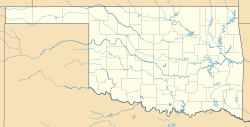White City, Tulsa facts for kids
Quick facts for kids |
|
|
White City Historic District
|
|
| Location | Tulsa, Oklahoma |
|---|---|
| Built | 1926 - 1930; 1946 - 1951 |
| Architectural style | Tudor Revival (1920s); Minimal Traditional (1940s) |
| NRHP reference No. | 01000663 |
| Added to NRHP | June 14, 2001 |
White City is a neighborhood in Midtown, Tulsa, Oklahoma. It's a special place because many of its old buildings are protected as part of a historic district. This means they are important to history! The neighborhood was added to the National Register of Historic Places in 2001. It has about 480 buildings, and many of them still look like they did a long time ago. White City is bordered by 2nd Street to the north, Fulton Avenue to the east, 11th Street to the south, and Yale Avenue to the west.
Contents
History of White City
The land where White City now stands used to belong to the Creek Nation, a Native American tribe. Later, a man named Edward Crowell owned this land. In 1912, Glenn T. Braden bought a big part of it from Crowell. Braden was the person who started Oklahoma Natural Gas Company.
The White City Dairy Farm
Glenn Braden built a dairy farm on the land. He called it the White City Jersey Dairy Farm. He even brought in a special group of Jersey cows. The farm got its name because all the barns and silos Braden built were white.
After Braden passed away in 1923, his children decided to close the dairy farm. They divided the land into smaller pieces, called lots, and started selling them. People could then build houses on these lots.
Building the Neighborhood
The White City neighborhood began to be built in 1926. At first, the lots were quite large, about 1 acre (0.40 ha) each. Many of the first houses built between 1926 and 1930 were in the Tudor Revival style. This style often looks like old English cottages with steep roofs and decorative half-timbering.
Building slowed down a lot during the Great Depression and World War II. But after the war, in 1946, homebuilding started up again. That year was the busiest for selling homes in White City! The houses built during this second period were mostly in the Minimal Traditional style. This style is simpler and more modern than Tudor Revival. Construction continued until the early 1950s, when all the available lots were filled.
What White City Looks Like
In 1999, a study looked at all the buildings in White City. It found that most of the buildings, about 77.5%, still looked like they did when they were first built. This means they contribute to the historic feel of the neighborhood. Some buildings had been changed too much or were too new to be considered historic.
The study also found that one house was built as early as 1915. Most of the neighborhood was developed in different sections over time. The first two sections, White City and Glen Haven, were planned in 1926. Other sections like Sanford Addition and Bowlin Acres were added later.
Braden Park: A Green Space
The old White City dairy farm had a pond that gave water to the animals. In 1926, this pond became the center of a new park called White City Park. The pond was made smaller, and a fountain was added. The park, which is about 10 acres (4.0 ha) big, was beautifully landscaped.
Later, the park was renamed Braden Park, in honor of Glenn T. Braden. It is still a city park in Tulsa today. Braden Park has fun things for kids and families, including tennis courts, picnic tables, and two playgrounds.



